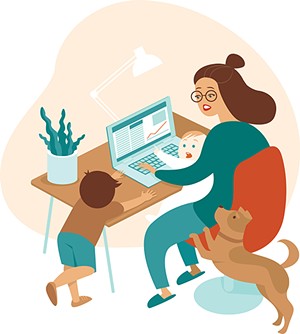Experts confirm working mothers are bearing the brunt of the pandemic. They overrepresent frontline workers and are taking on more responsibilities at home. "This could be a ticking time bomb for women in the workforce," Elizabeth Powers, associate professor of economics with the Institute of Government and Public Affairs at University of Illinois at Urbana-Champaign, told Illinois Times.
The U.S. Census Bureau reported March 3 that the number of mothers working decreased significantly more than fathers last year when schools shut down. Nationwide, mothers in the workforce declined 21.1 percentage points, but the share of fathers dropped only 14.7 points, according to the report. In Illinois, capacity restrictions and revenue loss led businesses in retail, service, hospitality, health and leisure to lay off workers en masse last year. As a result, more than 120,000 workers from these labor markets sought unemployment benefits. In Illinois these are labor markets traditionally dominated by women, particularly women of color.
An Illinois Department of Employment Security (IDES) report from December 2020 shows women made up 46.9% of all workers in the state. Women represented 99% of preschool and kindergarten teachers, 89% of child, family and school social workers, 77% of restaurant servers and 88% of maids and housekeeping personnel throughout the state. "Overall, mothers across all race and ethnic groups faced challenges in the labor market but nonwhite single mothers were hit hardest," according to U.S. Census Bureau analysis.
Last year in Illinois, 46% of women who provided housekeeping services were Latina. Black women represented more than a third of women working as home health aides in Illinois and 25% of women working in social services, according to IDES data. Accommodations allow some women to work remotely from home. But those who work in housekeeping and as caregivers aren't allowed that privilege. The pressures of COVID-19 and lack of affordable child care is "especially hard for many women of color," according to the U.S. Census Bureau.
American Center for Progress (ACP) reported last October that women of color are "feeling the multiple effects of being more likely to have lost their jobs." This is true for several reasons, including "policy choices grounded in racism and sexism," that leave low-wage workers, single mothers and women of color without access to affordable and stable child care. This has been exacerbated because of COVID-19, according to the report.
"Some women are getting discouraged in the labor market, more so than men," said Powers. "There's a core of women who have all these home responsibilities that actually keep them out of the labor market," she said. "Then I think there might be a group of other women who are underemployed," Powers added. These are women holding jobs but rearranging work schedules to limited hours based on a lack of child care. Other mothers may not be actively searching for employment opportunities "because it is just not practical given their home arrangements," said Powers.
White and wealthier women are more likely to leave their jobs, while women of color and low-paid women are more likely to stay in the workforce by rearranging schedules or seeking alternative child care solutions, a Feb. 1 ACP report found. Powers and other experts suggest access to child care is the primary reason for women's hesitant reentry into the workforce. "Child care has long been severely underfunded, leaving child care providers with razor-thin budget margins, child care workers with low pay, and families without affordable, quality care," the ACP article reads.
Contact Madison Angell at [email protected].


